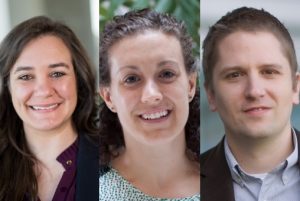
University of North Carolina Lineberger Comprehensive Cancer Center researchers and collaborators have discovered how a cellular signal that’s abnormally hyperactive in cancer can be deactivated.
In the journal Cell Reports, UNC Lineberger’s M. Ben Major, PhD, and colleagues published a paper on how the WNT signaling pathway is regulated. WNT proteins increase tumor onset, growth and metastasis, Major said. Inappropriately high WNT activity is known cause and contribute to several types of cancer. Loss of the WNT pathway also contributes to human disease, namely neurodegenerative disease and bone disorders, Major said.
“The WNT signaling pathway is a major regulator of human disease,” said Major, who is an associate professor in the UNC School of Medicine Department of Cell Biology and Physiology. “The pathway is frequently mutated and aberrantly active in many cancers. It is also downregulated in neurodegenerative diseases and plays fundamental roles in bone density disorders. The discovery of new mechanisms the govern WNT signaling and the longevity of WNT activation is thus of great importance to basic biology and to human disease.”
Megan Agajanian, who is a graduate fellow in the UNC School of Medicine Department of Pharmacology and first author of the study, said they discovered a specific protein, the AAK1 kinase, that can block WNT signals by removing the receptors on the cell’s surface that trigger activation of the WNT pathway.
In addition, they developed a new compound that selectively blocked this AAK1 kinase – a tool they used in their studies to determine the role of the AAK1 kinase in downregulating WNT signals.
They used the compound to more fully understand the role of AAK1, but researchers say it could have applications in diseases which WNT signaling is downregulated, such as bone density disorders and neurodegenerative disease. There are AAK1 inhibitors in clinical trials, but Major said that a more selective compound could be beneficial.
For cancer, Major said the study furthers the understanding of WNT signaling overall, which is dysregulated and active across cancer types including colorectal, breast, lung and pancreatic cancer.
“Working with Dr. Alison Axtman and colleagues at the UNC Structural Genomics Consortium, we developed a new AAK1 inhibitor,” Major said. “This drug helped us solve a key piece of the puzzle of WNT signaling regulation.”
Major said his laboratory will continue to work to understand the interplay between AAK1 and WNT signals.
“Our ongoing work is focused on determining exactly how WNT stimulation results in AAK1 kinase activation,” he said. “We are also very interested in further developing the AAK1 kinase inhibitor as a therapeutic.”
Major was corresponding author of the paper. In addition to Axtman and Agajanian, Matthew P. Walker and Roberta R. Ruela-de-Sousa also were first authors. Other authors included D. Stephen Serafin, Alex D. Rabinowitz, David M. Graham, Meagan B. Ryan, Tigist TAmir, Yuko Nakamichi, Melissa V. Gammons, James M. Bennett, Rafael M. Couñago, David H. Drewry, Jonathan M. Elkins, Carina Gileadi, Opher Gileadi, Paulo H. Godoi, Nirav Kapadia, Susanne Müller, André S. Santiago, Fiona J. Sorrell, Carrow I. Wells, Oleg Fedorov, Timothy M. Willson, and William J. Zuercher.
Individual researchers were supported by the National Institutes of Health, the NIH T32 Predoctoral Training Grant in Pharmacology, the Initiative for Maximizing Student Diversity Grant, and the NIH NCI NRSA Predoctoral Fellowship to Promote Diversity in Health-Related Research, the Lymphoma Research Foundation, the Japan Society for the Promotion of Science, the Howard Hughes Medical Institute Gilliam Fellowship for Advanced Study, and Cancer Research UK. The UNC Flow Cytometry Core Facility, which was involved in the research, is supported by a grant to UNC Lineberger. The research was supported by the Center for AIDS Research.
